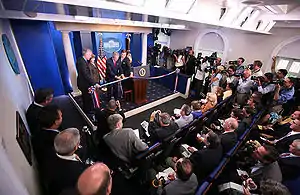
.jpg.webp)
The James S. Brady Press Briefing Room is a small theater in the West Wing of the White House where the White House press secretary gives briefings to the news media and the president of the United States sometimes addresses the press and the nation. It is located between the workspace assigned to the White House press corps and the office of the press secretary.
History
The first presidential press conference was held in March 1913 in the Oval Office, during the presidency of Woodrow Wilson. Subsequently, until 1969, communications from the president and general press news conferences took place in various locations, including the Indian Treaty Room, the State Department auditorium, and the White House East Room.[1]
In 1969, to accommodate the growing number of reporters assigned to the White House, President Richard Nixon had the indoor swimming pool, which had been installed by the March of Dimes for Franklin D. Roosevelt, covered and turned into press offices and a lounge that could double as a briefing room.[2][3]
From August to November 1981, the room was refurbished at a cost of $160,566 after the General Services Administration found the terrace roof over the press center was about to collapse; first families had hosted parties there. The White House press corps was moved to temporary quarters in the fourth-floor auditorium of the Old Executive Office Building. Forty-eight theater-style seats, blue and white tweed wall-to-wall carpeting, off-white wall coverings and a larger podium were added. On November 9, 1981, President Ronald Reagan and White House Press Secretary James Brady cut a red white and blue ribbon to open the remodeled facility. It was Brady's first official White House appearance since he had been shot on March 30 during an assassination attempt on Reagan.[4] In 2000, the room was named the “James S. Brady Press Briefing Room” in his honor. [3]
Renovation
In December 2005, the White House announced the intention to renovate the aging Press Briefing Room and cramped press corps offices.[5] On August 2, 2006, the final briefing was held, and President George W. Bush hosted several previous press secretaries at a closing ceremony and there was some hesitation and concern about whether the press would be allowed to return to the White House.[6][7] In the interim, the White House Conference Center was used as temporary location for press conferences.[8]
President Bush reopened the renovated room in a ribbon-cutting ceremony on the morning of July 11, 2007. He held his first formal press conference in the new briefing room the next day, following the release of a report on the progress of the Iraqi government.[9] The modernization cost nearly US$8.5 million. Of that sum, $2.5 million was funded by the media, and the remainder was funded from tax revenue. Each correspondent's seat was priced at $1,500. Beneath the current press room lies the former White House swimming pool that has since become a computer server room.[10][11]
Location

References
- ↑ "Presidential Press Conferences". whitehousehistory.org.
- ↑ Collins, Dan (August 2, 2006). "Bush, Media Bid Press Room Farewell". CBS News. Retrieved 2012-05-09.
- 1 2 Watson, Robert P. (2004). Life in the White House: A Social History of the First Family and the President's House. SUNY Press. p. 84. ISBN 978-0-7914-6098-6 – via Google Books.
- ↑ “Brady Enjoys His Visit Back” Associated Press, November 10, 1981
- ↑ Vande Hei, Jim (December 27, 2005). "White House Press Room To Be Closed For Makeover". The Washington Post. Retrieved May 9, 2012.
- ↑ Yellin, Jessica (August 2, 2006). "White House Press Briefing Room Redo". ABC News. Retrieved May 9, 2012.
- ↑ Stolberg, Sheryl Gay (August 3, 2006). "White House Evicts Press, Temporarily. No, Really". The New York Times. Retrieved May 9, 2012.
- ↑ "Press Briefing Room". georgewbush-whitehouse.archives.gov. Retrieved 2023-03-30.
- ↑ Spetalnick, Matt (July 11, 2007). "Bush to Press: Welcome back. No questions, Please". Reuters. Retrieved May 9, 2012.
- ↑ Patterson, Bradley Hawkes (2002). The White House Staff: Inside the West Wing and Beyond. Brookings Institution Press. p. 144. ISBN 978-0-8157-6951-4.
- ↑ Dean, John W. (2005). Worse Than Watergate: The Secret Presidency of George W. Bush. Hardie Grant Publishing. p. 69. ISBN 978-1-74066-222-2.



